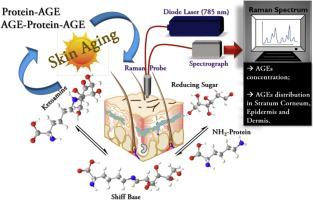Vibrational Spectroscopy ( IF 2.7 ) Pub Date : 2021-02-27 , DOI: 10.1016/j.vibspec.2021.103234 A.F.M. Pereira , B.V.M. Rodrigues , L.P. Medeiros Neto , L. de O. Lopes , A.L.F. da Costa , A.S. Santos , B.C. Viana , M.G. Tosato , G.C. da Silva , G.O.M. Gusmão , P.P. Favero , A.A. Martin

|
Advanced glycation end products (AGEs) consist of a complex and heterogeneous class of compounds frequently associated with the skin aging process. The formation of AGEs and its accumulation in the body have been related as the pathophysiological key to important age-related diseases, such as diabetes mellitus and Alzheimer’s disease. In addition, AGEs are also related to skin aging as result of ultraviolet (UV) light exposure in both senescent and photo aged skin. Thus, establishing novel approaches for spatially assessing AGEs appears as a potentially useful strategy toward the investigation of the mechanistic role of these compounds in aging-related processes. Herein, we propose a direct and non-destructive approach to assess the biological changes on the human skin highly exposed to solar irradiation. Confocal Raman spectroscopy (CRS) was used to evaluate the presence and the differences in the AGEs content, by using reference spectra of the major AGEs present in human skin. Two different groups were considered from volunteers who had a daily history of high sun exposure: samples collected from the inner face of the arm (sun-protected or low direct sun exposure, SP) and samples from the forearm dorsum (sun-exposed or high direct sun exposure, SE). In this study, the main AGEs products were found to be carboxymethyl-lysine (CML), glucosepane (GLU) and pentosidine (PEN) for both groups; while CML were predominant at the stratum corneum and epidermis, GLU and PEN were found to be the main AGEs in dermis. Multivariate statistical analysis revealed a high discrimination rate in the stratum corneum region at around 93.8 %, while in the layers of the epidermis and dermis this value was found to be 68.8 %, according to the degree of discrimination of SP and SE groups. In sum, this investigation shows that CRS is able to assess AGEs in vivo and non-invasively on human skin and provided a better understanding on the effects and changes resulting from skin chronological aging caused by glycation under conditions of high exposure to UV irradiation.
中文翻译:

共聚焦拉曼光谱作为评估暴露在阳光下的人类皮肤上高级糖基化终产物的工具
先进的糖基化终产物(AGEs)由一类复杂且异质的化合物组成,这些化合物通常与皮肤衰老过程相关。AGEs的形成及其在体内的积累已成为重要的年龄相关疾病(如糖尿病和阿尔茨海默氏病)的病理生理关键。此外,AGEs还与衰老和光老化皮肤中的紫外线(UV)暴露有关,与皮肤衰老有关。因此,建立用于空间评估AGEs的新方法似乎是研究这些化合物在衰老相关过程中的机械作用的潜在有用策略。本文中,我们提出了一种直接且无损的方法来评估高度暴露于太阳辐射下的人类皮肤上的生物变化。通过使用人类皮肤中主要AGEs的参考光谱,使用共聚焦拉曼光谱(CRS)评估AGEs含量的存在和差异。每天有高日照病史的志愿者分为两组:从手臂内表面采集的样品(防晒或低直接日照,SP)和从前臂背采集的样品(日晒或高日照)。阳光直射,SE)。在这项研究中,两组的主要AGEs产品是羧甲基赖氨酸(CML),葡萄糖窗格(GLU)和戊糖苷(PEN)。CML主要发生在角质层和表皮,而GLU和PEN是真皮的主要AGE。多变量统计分析显示,角质层区域的识别率很高,约为93.8%,而在表皮和真皮层中,根据SP和SE组的区分程度,该值为68.8%。总而言之,这项调查表明CRS能够评估AGE在体内和无创地对人类皮肤产生影响,并更好地了解了在高暴露于紫外线照射条件下糖基化所引起的皮肤按时间顺序老化所产生的影响和变化。










































 京公网安备 11010802027423号
京公网安备 11010802027423号